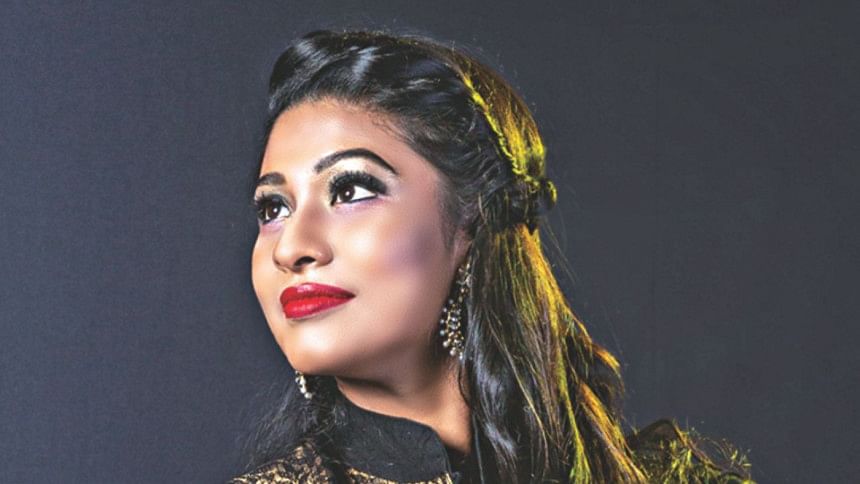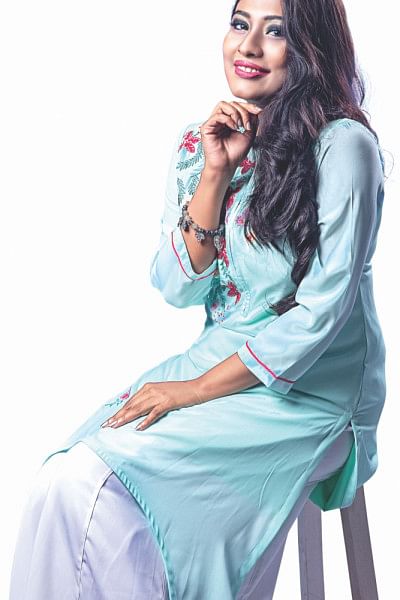Poojs Passions

Rafi: How have you been doing, Pooja?
Pooja: Never been better.
Rafi: That's great. At a time where almost everyone has a pessimistic answer to this very question, your response has amazed me.
Pooja: Whenever I am asked the question I have always responded the same way. Never comes a day when I forget to thank the Almighty for the blessing of a content life. I am pursuing my dream career. A beautiful life it is.
Rafi: Your father was an actor. What made your interest incline towards dancing rather than acting?
Pooja: Dance has been a part of my life from a very early age. May it be acting, singing, dancing, painting or reciting, my mother has made me try them all alongside my education. Soon I came to realize that my passion for dancing surpasses them all. Dancing makes me immerse myself in a different universe, in the realm of moves and rhythm. Hence this inclination towards dancing has always been greater

Rafi: It has been noticed that in our country often dance artists change their career track to pursue acting or modeling. Why do you think this is happening?
Pooja: Every art demands a platform, an ultimate destination. After year of lessons and training, a dance artist would ask for a solid ground to perform on rather than staying just as a background dancer for most of their career. Take our neighboring country as an example. People in Kolkata groom themselves to become meticulous dancers for years with the aim that one day, when they become well-trained, they will perform at The Uday Shankar Dance Fest. Getting the scope to exhibit their talent in such a platform will not only bring them into the limelight but will also add wings to their career as a dancer. They have and thus can plan a future revolving around dancing. Our country lacks this arrangement for dancers completely so whenever they come across some good offers they tend to get deviated from the field.
Rafi: Do you think the scenario for dancers has changed now?
Pooja: Though very few to count, but we do have eminent dancers in our country. Parents nowadays are more enthusiastic about this talent in their children and seek suggestions to carry this through in the long-run. All these marks that the society, for dancers, is taking a positive turn.
Rafi: Do you plan to curve your career as a dancer only or have different plans for the future as well?
Pooja: I have outlived that phase of career when I could be unsure of what I am doing. After completing my studies from India as I returned back I got many acting offers. But I have always wanted to pursue my career in the field of dance. In doing so, I have always tried to incorporate my other talents, e.g. acting, reciting into my performance.

Rafi: Being a 'Bharatnatyam' dancer yourself, do you think, partly because of the fusion era and partly due to lack of polishing, the authentic classical dance forms are getting extinct?
Pooja: Classical Dance will always be evergreen. But if an art cannot be molded as per the era, the art no longer stays alive, it dies. Thus, the experts add some contemporary touch to the form while teaching the new generation and this is how it flows. The more arguments arise on an art form, the more successful it is considered as then the art form grabs the attention of them all.
Rafi: In an argument, if there is as you said, who raises the questions?
Pooja: Changes are not favorable to many. To me, adding up one's creativity to a form makes it multidimensional.
Rafi: It is heard that dancers do not share a very friendly community among them. Conflicts with each other are common. How much of this is true?
Pooja: (Giggles) The field of dancing is yet to become an industry for our country. A platform having talents but lacking proper attention is bound to have conflicts. With increase in compass, these things will fade away. I think the situation is no longer as such in Bangladesh. It has improved a lot. We are getting called to perform in prestigious platforms. Things are getting better gradually.

Rafi: Tell us something about 'Turongomi'.
Pooja: Turongomi is a repertory dance theatre. We're a team which performs together on different stages.
Rafi: Do you think audiences are turning towards dance shows now?
Pooja: People are very interested towards dance shows. Jatiya Natyashala gets a good crowd when there is a dance show and the programs mostly get full house audience.
Rafi: How many shows do you conduct per year?
Pooja: We have done four shows a year. In 2015 we have performed the Waterness, an act of Bangladeshi Dance Theatre genre. It was a sponsored show and we staged it 4 times in Bangladesh. In 2016, besides performing in Bangladesh, we have staged Waterness, in Kolkata as well. We got the chance to perform in Asian Conference for River Festival which took place in Bangladesh on 2017. We even performed at the 11th The Daily International Art Fest. It was a stage where prestigious dance artists like Kumar Sharma performed. Our performance garnered tremendous appreciation there and thus we were felicitated by His Excellency- the High Commissioner when we returned to Bangladesh. Another production, Anamika, which got unveiled at the Bangkok Art and Culture Centre was staged in Vietnam International Fest. We were invited to dance by the government of Vietnam. This year we have also performed Anamika at the Philippines Dance Exchange.

Rafi: You have gained a lot in such a short time? What are your future plans regarding the field of dance in this country?
Pooja: My first and foremost intention was to bring dance on the first line of professional interest rather than a sideline practice as a pastime or hobby. Though my field of study was Bharatnatyam and Classical Jazz, I tried to incorporate my learnings in this country's contemporary dance form. But what I came across was the fact that, with changes in dynasty in this part of land in ancient times, the field of dance has faded away. But what this country has is a rich cultural background and literature. I am trying to contemplate and exhibit that literature in my form of dance.
Rafi: Have you got to extract some native dance forms through your research?
Pooja: Yes, there are some. For example: the dance form of the tea leaf pluckers of Sreemangal, the dance of the Shaotal tribes. Though there's not much originality left but still they exist. I gave these dance forms a name- Bagainna Nach. There are some other forms too but our neighbouring countries being advance culturally has taken and branded those forms long before we've even realized.
Rafi: Where do you think the dance of our country stands on international perspective?
Pooja: We're excelling gradually. Long gone are those days when people used to think dance has no future in this country. If you love doing the work, success is going to find its way towards you –that is what I believe.
Rafi: Hearing about your journey and the evolution of dance in our country from you has been really pleasant. I want to wish you very good luck with your future endeavours.





Comments